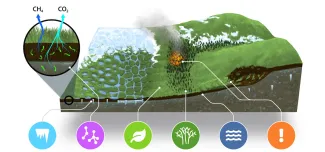Mod-Ex Question 1
MEQ1: Permafrost - Topography - Hydrology
How do permafrost, topographic, and hydrological properties co-evolve and affect carbon and energy fluxes?

Landscapes in Transition A mechanistic understanding of what controls the coupled nature of hydrology, biogeochemistry, and vegetation dynamics is needed for system-wide understanding and prediction of a range of tundra ecosystems underlain by continuous and discontinuous permafrost. NGEE Arctic research activities are designed to identify and quantify the mechanisms underlying processes.
These are the Science Questions that NGEE Arctic seeks to answer:
MEQ1: Permafrost - Topography - Hydrology
How do permafrost, topographic, and hydrological properties co-evolve and affect carbon and energy fluxes?
Vegetation - Biogeochemistry
How do patterns of hydrology, disturbance history, and edaphic properties drive vegetation and biogeochemistry to affect land-atmosphere fluxes?
Snow - Vegetation - Permafrost
How will warming and seasonality of vegetation and snow processes, including energy and water balances, alter permafrost and carbon dynamics across the landscape?
Shrub Dynamics
What controls the distribution of shrubs, and how will shrub distributions and associated climate feedbacks shift with warming in the 21st century?
Watershed Hydrology
Where, when, and why will the Arctic become wetter or drier, and what are the implications for climate forcing?
Disturbances
What controls the vulnerability of Arctic ecosystems to disturbance, and how do disturbances alter the structure and function of these ecosystems?
Data Synthesis and Model Evaluation Crosscut
The Synthesis and Evaluation Crosscut is gathering, integrating, and synthesizing measurements and observations at site, regional, and pan-Arctic scales to provide the data necessary to initialize, parameterize, and evaluate model simulations conducted in Phase 4 to address MEQs and support other crosscutting science activities.